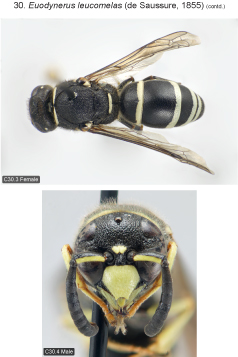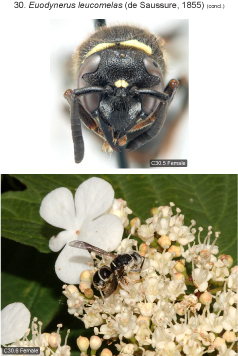
| Home | Table of contents | Keys | Species list | Glossary | Image data | PDF | Cite this article | Feedback | Updates |
Identification Atlas of the Vespidae (Hymenoptera, Aculeata) of the northeastern Nearctic region
CJAI 05, February 19, 2008
doi: 10.3752/cjai.2008.05
Matthias Buck, Stephen A. Marshall, and David K.B. Cheung
Department of Environmental Biology, University of Guelph, Guelph, Ontario, Canada N1G 2W1
Next species | Previous species | Key
30. Euodynerus leucomelas (de Saussure, 1855)
Figs B5.10, 13, 16, 17, 44, 49; C30.1–6.
 |

|
 |
Taxonomic note. The specimens treated here as the ‘yellow colour form’ of E. leucomelas present a difficult taxonomic problem. Specimens with these characteristics are rare in collections (ca. 30 specimens examined), and have so far been found only in Ontario and the following states: NH, OH, NJ, MD, WV, NC, and FL. Morphologically they are not clearly separable from Euodynerus fedoris (Bohart, 1945) stat. n., a taxon described and recorded only from Texas. Euodynerus fedoris is currently treated as a synonym of “Euodynerus foraminatus blakeanus” (Krombein 1979) but actually represents a species different from both E. foraminatus and E. blakeanus (species status see above). All three species occur sympatrically in Lee Co., Texas (material at USNM and BMNH) where they can be separated without difficulty based on structural and colour characters. Typical E. fedoris from Texas are similar to E. blakeanus but differ from the latter in the same way as E. leucomelas (see couplets 7 –13 of Euodynerus key), except for the fact that some females show small yellow apical clypeal spots. In addition, females and most males of E. fedoris lack black markings on the femora and on the scape (present in E. blakeanus). Yellow markings of E. fedoris from Texas are even more extensive than in E. blakeanus from Texas. The only characters that distinguish E. fedoris from the ‘yellow colour form’ of E. leucomelas are the greater extent of yellow markings and replacement of black markings on legs and scape by reddish markings. This might be due merely to geographic variation as more extensive yellow markings are also observed in Texan populations of E. blakeanus (but not in Texan E. foraminatus s. str!). Due to the scarcity of material in collections and insufficient sampling in Gulf Coast states we are presently unable to determine with certainty whether E. fedoris is a good species or merely a southern geographic race of E. leucomelas. If the former is true then what is interpreted here as the ‘yellow colour form’ of E. leucomelas might in fact be a northern race of E. fedoris.
Species recognition. This species is most similar to E. planitarsis, with which it shares the ivory colour of its pale markings and the presence of well-developed apical fasciae on at least terga 1–4. The yellow colour form, which is rare in the northeastern Nearctic closely resembles E. blakeanus and E. foraminatus. Euodynerus leucomelas differs from these three species by the characters given in the key. Euodynerus leucomelas and E. blakeanus are the only eastern Nearctic species in the foraminatus-group with relatively small flagellomere XI and short-haired ventral surface of the fore femur.
Variation. Fore wing length 6–8 mm (♂♂), 8–9.5 mm (♀♀). Pale markings usually ivory, sometimes pale yellow (especially in male), rarely bright yellow as in E. foraminatus. The yellow form of E. leucomelas was previously unrecognised and has been confused with E. blakeanus and E. foraminatus. Only four specimens (3 ♂♂, 1 ♀) of the bright yellow form are known from eastern Canada. The percentage of yellow specimens seems to increase southward, but one bright yellow male was collected as far north as Sudbury, Ontario. Towards the southern limit of its range the yellow form might be only form that occurs. In bright yellow specimens the pale markings are much more extensive, which is especially obvious in the female.
Female clypeus usually black, sometimes with a pair of dorsal spots, rarely confluent (usually with arcuate dorsal spot yellow colour form). Scape black, with pale stripe below in yellow colour form. Female mesopleuron with small or large pale dorsal spot. Female rarely with a pair of small pale spots on scutellum. Female tegula almost always marked with pale posteriorly and often anteriorly, in male pale markings often very reduced, sometimes absent. Parategula usually marked with pale in female, usually black in male (usually marked with pale in yellow colour form). Propodeum sometimes with pale spots on dorsal surface and on ventral half of lateral ridge in yellow colour form. Metasomal terga 1–4 always fasciate, in female sometimes also tergum 5 medially, in male tergum 5 usually and middle of 6 sometimes. Apical fascia of tergum 2 hardly extended forward on sides, except in yellow colour, where the apical fascia typically forms a subtriangular anteromedially directed extension from both sides. Female sterna 2, 3 and rarely 4 with posteroapical pale spots, rarely absent on 3 (in yellow colour form sterna 2–4 with spots); male sterna 2–4 and sometimes 5 with posterolateral pale spots, on sternum 2 usually extended towards middle and sometimes forming complete fascia; apical fascia complete on male sternum 2 in yellow colour form and sometimes also on one or more of the following sterna (present on sterna 2–6 in extreme cases). Female tibiae usually black, sometimes more or less extensively marked with pale on outer surface (especially hind and mid tibia), but tibiae almost completely yellow in yellow colour form. Female tarsi predominantly black; yellow to reddish in yellow colour form.
Distribution. Canada: all provinces (not recorded from LB), YT. Northern and western U.S., south to NC, TN in the east and NM, AZ in the west (Krombein 1979). The western ssp. oregonensis (Bohart, 1948) ranges from WY to WA and south to OR and NV.
Biology. Nests in cavities in sumac twigs. Nest partitions and closing plugs are made of mud. Caterpillars of Crambidae (Pyraustinae), Pyralidae, Pterophoridae, Tortricidae, Gelechiidae, Geometridae, Nolidae and Erebidae (Herminiinae, formerly Noctuidae) are used as prey (Fye 1965, Krombein 1979). All prey records stem from trap nest experiments conducted by Fye (1965). Because Fye did not separate E. leucomelas from the closely related E. planitarsis (material examined in CNCI), there remains some doubt about the correct prey associations.
Next species | Previous species | Key
| Home | Table of contents | Keys | Species list | Glossary | Image data | PDF | Cite this article | Feedback | Updates |
